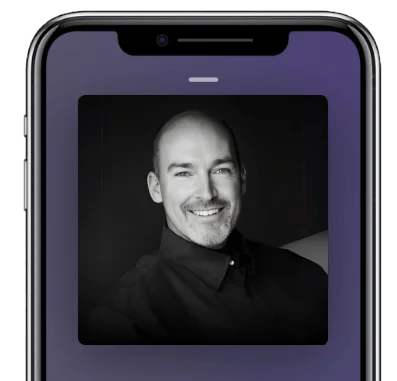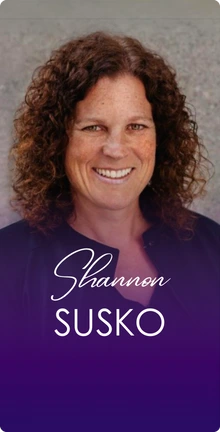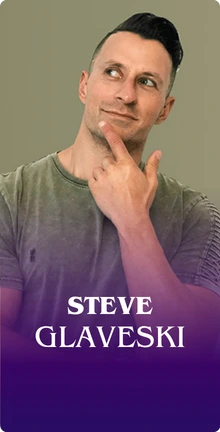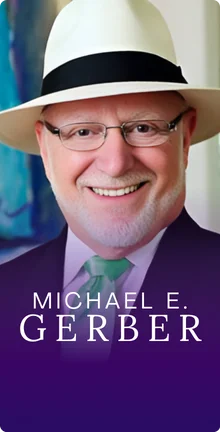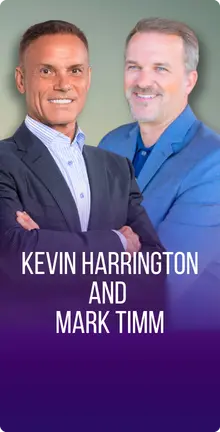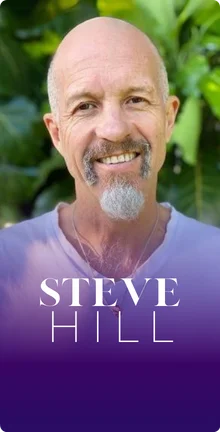In this Episode
- [00:44]Stephan introduces Gino Wickman, founder of EOS Worldwide, and the bestselling author of the books Traction: Get a Grip on Your Business, How to Be a Great Boss, and What the Heck is EOS?
- [01:53]What does EOS stand for and how is it a gamechanger?
- [11:41]Are you thinking about taking that entrepreneurial leap?
- [15:55]The six essential traits of a true entrepreneur.
- [19:50]Why the sections called Confirm, Glimpse, and Path are considered crucial in one’s entrepreneurial leap.
- [24:50]What is the difference between lifestyle business and lifestyle entrepreneur?
- [39:46]Why knowing your customers’ wants and needs help you capitalize on solving their problems.
- [43:38]Gino shares his favorite, tried and tested tips in starting a business.
- [50:13]Gino recommends a list of assessments to take before deciding on investing in a business.
- [58:05]Visit Gino Wickman’s website at e-leap.com and follow them on their social media accounts.
Gino, it’s so great to have you on the show.
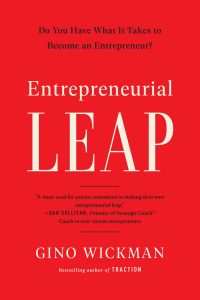
Glad to be here, Stephan.
First of all, let’s talk a little bit about EOS. Many of our listeners have not even heard of it before. I hadn’t heard of it before, let’s say two years ago. So, what is it and why is it such a game-changer?
It stems from 10 years of obsessing about entrepreneurs and businesses, taking over a family business, doing a turnaround, running that business, selling that business, getting involved in the Young Entrepreneurs’ Organization and getting involved in the Strategic Coach. All of these data points that came together upon transitioning out of the business, the family business I sold, I then took a leap once I realized what my true god-given abilities were and that’s helping entrepreneurs.
I set out to help entrepreneurs and took all of that experience. Over a five-year period, I developed EOS which is known as the Entrepreneurial Operating System. It is an operating system, the original operating system for a business for orchestrating and harmonizing human energy. It’s a system that helps an entrepreneur and their leadership team run a better business.
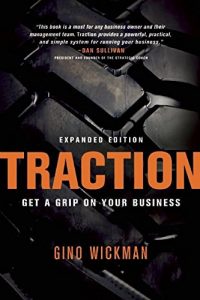
The typical sweet spot is a 10–250 person privately held company. That’s where about 80% of our clients reside. We’ve got almost 100,000 companies using those tools. As you shared, I’ve written five books around it. They sold over a million copies, so we’re just putting a huge dent in the entrepreneurial universe, helping people run better businesses. At the end of the day, that’s what it does. It manages the human energy in your organization, helping you to run a better business.
I can vouch for how it’s changed many businesses because not only have many of my friends implemented EOS and gotten a lot of value out of it but some of my clients have, too. In fact, one of them, BorderBuddy, relaunched their website with my help—I was spearheading that whole project—but they wanted to make sure that they talked about EOS in their About page because it was so transformational.
They’ve got a picture of the book cover, Traction, on their About page and a whole write-up about how transformational it was for their business. It’s one of their milestones on their timeline on their About page.
It’s just so crazy to hear that and it’s a dream come true. We’ve got cities now when an employee is looking for a job, they’ll only work for a company running an EOS. I mean, how crazy is that? I certainly expected that many companies would run on that system and we changed a lot of lives. I did not expect what’s the reach that we’ve had and the reach that we’re going to achieve over the next 10 years.
Right. In fact, some of the people who have interviewed for jobs working for me have said, “I’m an integrator or whatever, an EOS so I’d be a perfect fit. There’s another way in and so forth.” Amazing, right? You have changed the world.
Yeah, I get too much credit. At the end of the day, all I am is this obsessive guy that all I do is focus on how to make an entrepreneur’s life better. Again, I spent those 5 years working with 50 companies, 500 sessions, and I just listened to all their problems. I also have an ability to simplify so I just take the 20/80 approach to the world and figure out the 20% that will get a company 80% the results, put that into a simple set of 20 tools and so far, it’s working. I created it to be timeless. Hopefully, it’ll still be around in 100 years, but so far, 20 years and running, it’s still alive and well.
That’s great. I bet these tools are very instrumental and helpful for folks who are having to downsize or pivot in various ways because of the economic downturn and the pandemic. You’re helping business owners be resilient and dare I say, even antifragile and being able to thrive in times of strife and trouble like this.
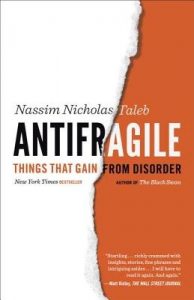
I love that word and I love that book. That’s near and dear to my heart and that we helped a lot of companies through 2008 and 2009 and we’re about to do it again, so you’re right. The companies that are running on this system are surviving and thriving. It’s all about going back to the basics right now. Everybody’s got to get back to the basics. We’ve had this incredible 11-year run and so all the entrepreneurs that were spawned in 2008–2009 don’t know tough times. They’re all getting a wakeup call and it’s getting back to the basics, everybody. That would be my humble two cents.
What’ll be an example of the 20 tools that would be especially helpful for somebody who already runs a business and is facing things like potential layoffs, cost-cutting measures, cutting back on their marketing spend, perhaps those sorts of things?
All 20 tools are very powerful on their own. Five of those tools, we consider the foundational tools. I wish I could give the perfect answer because every company out there is experiencing something different because this one is really unusual. In 2008 and 2009, it was most companies that we had to help really turn the corner. All of the clients and companies and entrepreneurs that I talk to right now, it’s this interesting 50/50; 50% are thriving. They’re in the right place at the right time and they’re in a really good spot. 50% are getting their ass kicked. It really depends who we’re talking to and it also depends how extreme it is.
One thing we’re helping companies do that has experienced, let’s say, a 50% drop in revenue and they have to do layoffs—they have to do layoffs for survival, unfortunately—there’s a tool we teach called Accountability Chart. Most of the good years, it’s all about anticipating growth and putting the right structure in place to get you to the next level. Well, with an Accountability Chart in times like this, with somebody that takes that kind of a hit, we teach the Reverse Accountability Chart and you mentally have to shift your brain.
It takes a team an hour. We’re working on them for an hour, getting their brains in survival mode. You’ve got to do a Reverse Accountability Chart. You got to look at the structure for $10 million in revenue. What’s the structure for $5 million in revenue? They just have to rethink. There are leaders that are having to do jobs they used to do 8 years ago when it was a $5 million company. That would be one example of a tool. Certainly, meeting with your team—we teach a level 10 meeting—a very powerful meeting where the team comes together and focuses on what’s important. I can keep going. I wish I could pick the perfect one.
Clearly, our listeners need to go check out Traction and your other books about EOS and maybe even hire an EOS consultant to help them because you’ve got a whole worldwide network of them, right?
Yeah, we call them EOS implementers and there are 350 all over the world.
That’s great. Now, the Reverse Accountability Chart and tool, that sounded very similar to something I just learned from Shannon Susko. Do you know who Shannon Susko is?
No.
A true entrepreneur in the making has six essential traits. They are: visionary, passionate, a problem solver, driven, a risk-taker, and responsible. Share on XShe is the creator of the concept of the 3HAG. Do you know the 3HAG? 3-Year Highly Achievable Goal. There’s the BHAG, the Jim Collins’ Big Hairy Audacious Goal but the 3-year Highly Achievable Goal or 3HAG is something that people can kind of wrap their heads around to this is not too far in the future like five years and it’s not right around the corner like one year, so you’re not just in a flight or fighting mode with the one year, and you just make it very achievable. That sounded great.
I had her on my show. I talked to her about her books and her concepts. One of the concepts that have been just hugely valuable for me—I’ve been going through this exercise myself—is starting from the bottom up and figuring out if you have no clients left, everybody goes away, what happens in terms of your cash over the next period of weeks or months? When do you run out of cash? What are your days of cash that you have left? If only your very best, most loyal, most resilient clients to this economic downturn stay with you, what kind of expenses do you have? What kind of skeleton crew do you have, etc.?
Then, one level up. What if my next most loyal clients stay and are not quite as resilient, but maybe cut back a bit. What kind of revenue and what kind of expenses? Then, just work your way up because going from the top down, making cuts and then figuring out what your business is going to have to be like without, let’s say, 10% of your staff, which 10% do I lay off, etc.? Then, what if things get even worse and then I go 20% into my layoffs and so forth?
Psychologically, that is so hard and we just procrastinate that we don’t want to do it and I didn’t want to do it. I’ve lost my three biggest accounts in the last month. It is so painful. I’ve been delaying what kind of cost-cutting measures I need to do. Now, I have this methodology to start from the bottom and work my way up. It sounds somewhat similar to your Reverse Accountability Chart. What do you think?
Definitely. It’s in that same vein, the 3HAG as you describe, it’s very much in alignment with our philosophy in that for 20 years, we’ve been teaching three-year picturing. We teach you how to create a three-year picture for the organization. It’s very similar, so yeah, it sounds like she knows what the heck she’s talking about.
Cool. Let’s start moving into this conversation around folks who want to make that leap and become an entrepreneur. Perhaps they have an activating event like a layoff that has pushed them to this point and they need to see if they’ve got the gumption to do it, the tools, the resources, and the resourcefulness, of course, you got this great book. How do we tell them to assess whether they’ve got the chops for this or not?
That’s awesome. Let me create a little context as we now shift into this new project. I want to go back in the last 30 years of my life, three decades of obsessing about helping entrepreneurs have led me to write this new book and create this new project. The project, in a nutshell, is to help a million entrepreneurs in the making get a huge jumpstart on taking their entrepreneurial leap and greatly increase their odds of success.
There’s an old saying by Daniel Kanyam that says, “We teach what we need the most.” Basically, what I’m doing is I’m teaching my 18-year-old self, who was an entrepreneur in the making, who was lost, confused, and insecure. I was a mislabeled derelict, and at the end of the day, I was this entrepreneur in the making and I didn’t know it. It took me until the age of 29 to realize that I was an entrepreneur in the making.
As I was building EOS Worldwide over the last 20 years, when I was 40, I said, “Once I turn 50, I’m going to focus on entrepreneurs in the making. I’m going to go to the front end of the entrepreneurial journey and help these people.” That was at 40, I’m now 52. Two years ago, I turned 50. I actually sold EOS Worldwide. I sold the company. I still own 12.5%, I still own all the books, I’m still the EOS guy, I still have clients. Half my working life is still EOS but this is where my next passion is.
With that, what I’ve done is I’ve created content, put it in a book and tools on the website that basically takes someone who thinks they might be an entrepreneur in the making and takes them on a journey of discovery to decide. For your audience, you have people that are sitting there that may be wondering if they’re an entrepreneur in the making or thinking about taking their leap. This book is perfect for them. You may have people in your audience that are business owners, current and very successful entrepreneurs, and they have a passion for helping entrepreneurs in the making. They mentor them or they have an organization that helps them or they have somebody in their life, a child, a nephew, a niece that appears to be exhibiting signs of entrepreneurship. This book is for them.

There’s one little ancillary benefit I had never anticipated. When a successful entrepreneur reads this book, it lights them up because what you’re going to read is your life story. What it does is it kind of reinvigorates your entrepreneurial spirit and you will literally make two or three-course corrections on the path you’re on. It’s a cool exercise for somebody even in that state. But all that said, what I do with this content is there are three parts to the book. It’s called confirm, glimpse, and path. If you understand that there’s kind of a linear fashion to that.
First and foremost, confirm is all about confirming that the person is even an entrepreneur in the making in the first place. But a true entrepreneur in the making, a true entrepreneur has six essential traits.
The second part of the book then takes them to glimpse. Let’s assume we’ve confirmed that they’re an entrepreneur in the making. Now, we’re going to light them up by showing them a glimpse of what life looks like as an entrepreneur, all of their options. I show them a day in the life, countless real-world stories, and then that really motivates them to move.
Then, we go to the third part of the book which is the path. I show the path, guideposts, milestones on the journey to greatly increase their odds of success and to help them avoid half the mistakes they’re about to make. They’ll still make the other half. It’s all part of the process and the learning process. But that’s the content in a nutshell and we can obviously go wherever you want to go.
In answering your question you just asked there—I’ll start there, hopefully, the context is clear to your audience—when we say confirm and we talk about those six essential traits in all of my experience and all of my research has been done for 30 years and then testing it on every entrepreneur. There are 6 essential traits of every true entrepreneur. They are visionary, passionate, problem solver, driven, risk-taker, and responsible.
What I urge your listeners to do is just do a little checkup on themselves. If they are an entrepreneur, do a checkup on themselves. If they’re thinking about being an entrepreneur, I offer a free assessment. There’s an assessment in the book and I offer a free assessment on the website, they can go to e-leap.com for that assessment. All of that is around deciding, am I cut out for this thing? The passion and the message there is, I’m trying to talk people out of doing this if they don’t have the six essential traits.
I believe I’m doing a service. It is going to break some hearts, I know, but I’m trying to save someone 10 years of sheer hell if this is not what they’re supposed to be doing and just as quickly, I’m trying to find all the entrepreneurs in the making that exist in the world. I believe 4% of the world exhibits these traits, have these traits, you’re born with them, they cannot be taught, it is nature over nurture, and I want to find that 4% wherever they are—in college, working in the corporate world, in inner cities—wherever the heck they are, I want to find them and help them become the reason they were put on this planet and become what they were born to be.
Wow. How did you come up with 4%?
I think it stems from the research Mark Winters and I did in our book, Rocket Fuel. A lot of your listeners might be familiar with the concept I created called Visionary Integrator, a discovery I made, and we now help a lot of businesses run on that concept. Visionary is that entrepreneur that founded the company; typically needs to be counterbalanced with an integrator. Anyway, our research around visionary and talking to a lot of experts, we found the number to be about 4%.
A little fun fact. I’m a little bit of a tangent, will come back is only about 1% of the world are integrators. That’s really interesting, huge opportunities for the integrators of the world. Nonetheless, that work comes from that discovery. It seems to be 4% and that’s been validated a few times over. At the end of the day, these are my opinions, my research, my three decades, love it or not.
A successful organization is composed of a visionary and an integrator. There's only 5% of visionary entrepreneurs who have the ability to be both. If you’re a visionary who really wants to expedite your growth, get an integrator. Share on XWhen you explain the integrators and how they can kind of set their own path because they’re so rare and valuable, and that explains why he was this guy that I interviewed, who also is a friend, why he was touting so much that he’s an integrator in EOS.
I’m definitely a visionary, I need an integrator. I’ve got some great team members but I don’t have that special person, I have an integrator that I need to have in order to really expand the business.
Here’s another thing, too. I’ve come to realize in the 25-ish years that I’ve been owning, running, founding businesses—I did have a successful exit and stuff. This was my second. I’ve got two companies right now. I’m on my second run right now—that running a business $5, $6, $7 million business is hard for me. I’m not that good at that. I need to have a CEO or at minimum a COO, somebody who’s got the chops to help me do that because I can grow something from nothing to seven figures and blow seven figures. No problem.
You said so much there that I want to go in three different directions.
Okay, let’s do it.
I’ll let you rein me in, but it’s so interesting what you shared there. If I can continue to have your audience understand the context of the confirm, glimpse, and path, you touched on two very important things. One in path and one in glimpse. Let’s just pretend for the sake of this conversation, everyone listening understands how to confirm that you’re an entrepreneur in that whole piece of the book.
When you talk about this visionary integrator concept and the need for an integrator, in path, I’m teaching the nine stages of growing your business and one of those stages where you have to make a conscious choice as to when you need to hire or bring on your integrator. It’s a different answer for every entrepreneur and I believe every visionary entrepreneur should have one. There’s only 5% of visionary entrepreneurs who have the ability to do both, so if you really want to expedite your growth, get an integrator.
Sometimes economically, you can’t afford that. What I talk about and I teach is some entrepreneurs are able to, are savvy enough, and can afford right on the front end to either partner with an integrator or hire an integrator. It’s exactly what I did when I started EOS Worldwide because I knew the concept. Some will start at the beginning. Some can’t do it until they hit a million, some $10 million.
I have one client that did not hire their integrator until they hit $100 million dollars in revenue. It’s a different answer for everyone but this is baked into the content because for any visionary entrepreneur listening right now, you got to decide where and when is the right time to bring on your integrator. Read Rocket Fuel for more insight on that.
Now, you started talking about what you’re built for. This is so important. I really want to go here and I hope your listeners will have fun with this because going back to glimpse, as I share in glimpse, I’m showing that entrepreneur in the making, a glimpse of what their life could look like and all of the options. When I talk about the existing successful entrepreneur that reads the book and gets lit up and makes some tweaks and course corrections, one of the big parts is in what I’m about to share.
I created a tool called MyBiz Match. The idea behind that tool and my discovery in writing this is something that just kind of came into my brain in a flash, is every entrepreneur is built for a certain type of business. Every entrepreneur will not succeed in every business. It’s one of the biggest misnomers and the biggest mistakes that an entrepreneur that is successful in this business, sells that business, starts a completely different business and fails.
The point is, when you’re starting a business, there are 10,000 options. The fallacy that the billion-dollar tech unicorn is the only kind of business to build is maddening to me because there’s no shame in building a $5 million heating and cooling company that throws up a 20% profit.
The point here is if we now go through the list and you think about all of the possible industries that exist, and then from there we look at, are you more of a product person or a service person? Fundamentally, those two businesses could not be more different and we’re all drawn to one or the other. It’s really hard to be both. I’m a service person and then we go another level deeper. Are you a B2B entrepreneur or a B2C entrepreneur? Those are very different business models.
Then, we get into pricing. Are you high-price, high-value, low-volume or are you low-price, low-volume? I’ve got one client. They sell light bulbs. I’ve got another client that is selling their hourly rate at $1000 an hour. The point is we’re all built for something different. Then, we get to how big of a company do you want to build to your point. There are some entrepreneurs that are built for building a million-dollar company and there’s no shame in that. There are others that are built for a billion-dollar company. Not every entrepreneur is built for a billion-dollar company.

What I’m trying to do with this book is to get you to realize what you’re built for. Two of MyBiz Match resides on the website, it’s free and you can literally click through a bunch of answers and out pops the perfect business for you. Me, I’m a service guy, high praise. I always want to be the most expensive guy in town. I hate products, I hate inventory, it overwhelms me to see a million dollars of inventory sitting on the shelf.
When I look at the businesses, I’m a 50–250 employee kind of a guy. When you talk about $7 million is your number, I have a friend that has built three $10 million companies. He tried to build a $100 million company, but he failed. We’re all built for something different. There’s no shame at the end of the day. If your niche, your gift, you’re built for $7 million companies, amen and hallelujah because you’re already damn near one in a million just building a $7 million company. Long dissertation but did that prompt a lot for me but also, hopefully, help your listeners and viewers.
That’s awesome. So great. Now, one phrase that I’ve heard a number of times that I’m curious what your opinion is on sits the lifestyle business. It’s like, “I want to have a lifestyle business. I want to be able to travel and work 10 hours a week and just not have the grind of a regular business where you’re the last to get paid, the one who doesn’t get paid, or the one who takes the least amount of vacation or never gets a vacation.” They want a lifestyle business or conversely, somebody who says this as a derogatory thing. “Yeah, I’m not one of those lifestyle business owners. I’m not going to just be sitting on the beach all day. I’m going to build something of real value.” I’m curious where you’re at with a whole conversation.
Be still my heart, I love that question. On that exact question, there’s something I wrote about in the book and illustrate, and I’ll teach it all right here now called The Entrepreneurial Range. If you picture this range, this arc, on the right side of the range, I put true entrepreneurs. On the far left end of the range, I put self-employed. Anybody that owns a business and or is self-employed is somewhere on that entrepreneurial range. These six essential traits I’m describing are the people on the right side of the range.
If you think about redlining the right side, these are the greatest entrepreneurs of all time: Henry Ford, Thomas Edison, Oprah Winfrey, Sara Blakely, Elon Musk. These are the far right. If we go all the way to the far left self-employed, these are the lifestyle businesses, the freelancers, the solopreneurs, the one-person shows. There is no shame in being any of that.
What I’m saying is that person that does want the lifestyle business, amen and hallelujah, you’re taking the risk, you’re self-employed. I’m not going to call you a true entrepreneur with all due love and respect because my definition is that a true entrepreneur is on the right side of that range.
But I will tell you, yes, the people on the right side of the range are probably going to say something condescending about the lifestyle entrepreneur. And yes, the lifestyle entrepreneur is probably going to say something… So, let’s not even get into that. The point is, no matter where you are, it’s all admirable but it’s the ones on the left side that probably don’t have all six essential traits because it’s almost impossible for a true entrepreneur to have a lifestyle business because they can’t turn off their mind.
They see so many opportunities to solve problems and make money that they just find themselves with employees, with great products and services. They can’t stop themselves. I swore before EOS Worldwide, I was not going to build another organization. Within a very short period of time, I was building another organization. You just can’t stop yourself. Does that context help answer your question?
It does. I like that a lot. That also prompts me to ask another question because I’ve learned from Tony Robbins—I attended a lot of his seminars over the years and did his Platinum Partnership—he describes that there are three types of people in business. There are the entrepreneurs, the manager leaders, and the artists. He convinced me and I’m sure many of us in the room that we were actually artists and not entrepreneurs.
I do still identify as an entrepreneur, personally, but maybe I’m more of an entrepreneurial artist. I love inventing stuff, I love tinkering and reverse engineering, poking and prodding at the black box, whatever it is, if it’s a Google algorithm.
When I was a kid, I scrounged my own satellite dish when people had these huge 50-foot satellite dishes that were solid and not even mention and it was fun to try and find one for free that somebody was throwing out to replace with a mesh one, and trying to scrounge a receiver for free and everything—this was in the 90s—and I just love figuring stuff out.
So, am I an artist? Am I an entrepreneur? I’m definitely not a manager leader. I do okay with that but that’s not my gift and my team knows it. My team knows that they have to be very self-sufficient in order to thrive in my organization. I’m curious what your take is on all this.
Yes, that’s really good. Let’s do a process of elimination here because that entrepreneur he describes and that manager he describes, there’s that perfect visionary-integrator combo. In other words, to just kind of oversimplify that. Now, that leaves this artist, as he calls it, I call it the inventor but it’s all the same. That artist’s point is so important because rarely does the artist or inventor ever build a business because I think I have a lot of that in me. But at the end of the day, I’m an entrepreneur.
Vision without traction is merely hallucination. Share on XWhen you think of influencers, musicians, actors, and then the people you say that like to tinker in the lab and create stuff, very few of them are true entrepreneurs. Very few of them really build a business with people in it. They all generate a lot of money. I should say many of them generate a lot of money. Most of them are starving but a lot of them obviously makes a lot of money.
I do agree with him from that standpoint that there is that outlier and that is a real thing and you have to decide, in fact, is that what you are? But I couldn’t agree with him more. With that said, the inventor artist that decides to take their leap is almost always over here on the left side of that entrepreneurial range. They’re typically a one-person show. Again, that influencer is generating $250,000 a year up what they’re doing, but it’s just them and maybe an assistant. They tend to be more on the left side of the spectrum if they become self-employed because a lot of them go become inventors and artists for other organizations, corporations. Hopefully, that makes sense.
Right. So, they become a name on a patent that makes IBM, Google, or whoever richer. But that’s just kind of an ego thing that doesn’t really pan out for their retirement or whatever.
Most inventors and artists die broke. I mean, it’s a pretty sad state of affairs, frankly, because they’re geniuses and most of the time, they just don’t know how to monetize their genius.
Yeah. Didn’t Nikola Tesla die penniless?
I believe so.
That’s such a shame. This idea of figuring out your fit, if you’re the manager leader, in your terminology, that would be the integrator. If you are the inventor or in the other terminology, the artist, and then the entrepreneur. The way that Tony described it is that a true entrepreneur would be happy to swap out their services business for a toilet manufacturing business if the numbers worked out for you much better. It’s like, “Wow, this is a vastly more profitable business. I’m going to start manufacturing toilets.” They’re not wedded to creating this art, whether it’s a service or product or whatever. They’re like, “Yeah, toilets. That’s fine.” Would you agree with that?
It sounded like there is a little different opinion there from you with the types of entrepreneurs. Like I don’t think I’m as good of a fit for products as I am for services, though I did invent a product that we applied for a patent and everything. That generated a lot of revenue and we were able to charge on a cost per click basis for SEO services. It was such a great software as a service product. Then, the company got acquired.
I do have the chops to invent products and create a product-based business that appears to be a services business from the outside, but I gravitate much more towards services. Maybe there is some disagreement here about the nuances here. What do you think?
I’m trying to take it back to that entrepreneurial range. I’m saying that, yes, some inventors and artists will fall somewhere on that range. More of them to the left, I would say most of them to the left. I’m not going to debate Tony on his concept because I agree with that concept. I believe most of the artists and inventors never take the self-employed leap as the point I’m trying to make there.
The point about an entrepreneur is to literally wipe everything out and sell toilets because that’s where the money is. Where I don’t entirely agree with that is it goes back to what we talked about, what are you built for, and absolutely, an entrepreneur is going to turn their business on a dime.
What a great entrepreneur does is they know their customers and clients better than they know themselves. They have their ear to the ground, they evolve with the times and they keep providing them value. When they make that shift, it tends to generally be in the same ballgame because that’s what they’re built for. Rarely are they going to go from being a service-based training company to selling hotdogs on the corner stand. It’s rarely going to be that extreme. Pretty much we agree but that would be my answer.
Got it. I’m also curious, I’m thinking about another thought leader, expert, author, and this is Michael Gerber who has been a guest on this podcast, talking about the entrepreneurial delusion, how most people who are supposedly entrepreneurs are delusional about it. They’re not running a true business, they’re self-employed, they’re not a business owner or they’re working in the business, not on it, that sort of stuff.
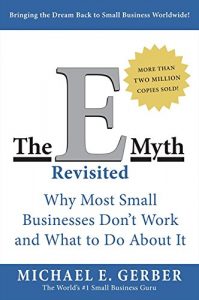
What he recommends in The E-Myth, The E-myth Revisited, and Beyond the E-Myth, all those books, is to start fresh with a new business, a new entity, could even be like a skunkworks-type entity inside of your big business and that entity has a new set of rules that’s truly entrepreneurial because trying to go back and fix a business that has been around for 5, 10 years, whatever it has, and then retrofit in all these new processes, procedures, a new way of being accountable and all that. Very hard to do, start from the beginning with a new entity. What are your thoughts on that?
That’s interesting. I don’t know if you’re going to take me through every thought leader that ever lived but I’ll say this about Michael Gerber. I am one of his biggest fans. I devoured all of his content in my 20s. He is the reason I was able to turn that family business around. I was armed with his book. I’m a huge fan. I actually had the privilege of having two conversations with him in the last 60 days. I loved that man and his work is incredible.
His concept of Entrepreneurial Seizure id they think that they’re an entrepreneur and takes that entrepreneur leap and fail horribly. That validates my point that not everybody’s cut out to be an entrepreneur. He talks about the three people in every organization. There’s the entrepreneur, the manager, and the technician. Again, what I’m teaching is that entrepreneur. He and I largely agree.
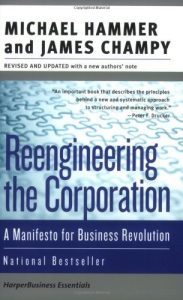
Right now, he does believe that he can turn anyone into an entrepreneur and that’s where we maybe disagree a little bit. But to reinvent your business, that’s what I had to do with the family business. Armed with his book and ironically, the book, Reengineering the Corporation, I think it was called. It was those two books. Absolutely, I borderline had to build that business from the ground up, but not every business needs to be completely reinvented to that level.
These days, it seems like if a company is going to be pushed to the brink to reinvent itself, it’s going to be with the times that we’re in with the pandemic. I think this is going to be a great depression. That’s my prognosis prediction, whatever. It’s going to be a lot bigger than a recession. I don’t know. Might even be bigger than the great depression of the 1920s, 30s.
You know why? I certainly hope you’re wrong. I’m not smart enough to put it.
I hope so, too.
As I said, what I’m finding is half the business owners I’m talking to are thriving. Half are getting their ass kicked. Of the ones that are getting their ass kicked, I find that most of them just need to get back to the basics. And yes, then there are some that have to totally reinvent themselves from the ground up. You’re 100% right. Many will not be able to do that, they’re not capable of doing that and sadly, those businesses will go out of business.
Do you think that folks who are just booming right now with their businesses because of what’s happening? Do you think they would get value out of reading this book or to be more about EOS? I’m thinking, for example, I’m going through this list of fastest-growing categories in e-commerce. I’m looking at this right now. It’s on stackline.com. Disposable gloves, bread machines, cough, and cold soups, dried grains and rice, packaged goods, fruit cups, weight training, milk and cream, dishwashing supplies, paper towels, hand soap and sanitizer, pasta, and vegetables. A lot of categories requiring people to stock up and fill up their bunker or whatever and also to work from home.
I’ve got a client in the computing space. They have all these options for upgrading your Macintosh with more memory, more hard drive space and so forth. They’re going like gangbusters. Every one of my clients is just kind of waiting for the other shoe to drop. They are looking at cost-cutting measures, too. They’re not just saying, “Wow, we’re a 20% up bureau over a year or 30%. Let’s just crush it and do things that nobody else is willing to do.” No, they’re also looking at making cuts, too. That would make me think that the next logical step in this would be to look for opportunities to reinvent.
If you’re a business that has a thousand people and they all work from your company headquarters, maybe it’s time to become a virtual company, remote workforce. It’s not just for the next several months or six months or I would predict 12–18 months but in actuality, maybe it’s permanent. Maybe they reinvent themselves to become a virtual business. I don’t know. I’m just prognosticating, but it seems to me like that maybe this book could be quite helpful for them thinking about how to reinvent and reengineer.
Yes would be the short answer. The longer answer is it depends on who they are and those examples I laid out with the 50/50 because probably most of those companies, it’s EOS and traction because they’ve just simply got to get back to the basics. I also think it’s really dangerous for you to prescribe one size fits all. “Hey, everybody, go become virtual.” That’s dangerous and I don’t do predictions. In other words, most of them are wrong.
But here’s what I know and believe. If we look at a thousand years of business history and the next thousand years, there are a couple of constants. I call it the things that change in the things that don’t change. One thing that’s ever-changing is the product and the service that we provide. Number two is the way we communicate and persuade people to buy our wares. 200 years ago, it was beaver pelts and buggy whips. God only knows what it’s going to be 200 years from now, but it’s going to be telepathy and populating Mars. I mean, I don’t know, but it’s ever-changing.
You and I, with all due love and respect, maybe you are the most intelligent man on earth, cannot predict. I cannot predict what the next great product or service is. But that’s the beauty of a true entrepreneur who has these six essential traits. They’re going to figure it out. The product or service is ever-changing and as I keep saying, that entrepreneur that keeps their ear to the ground, stays close to the customer, finds out what they need, is going to make that change. Please don’t wait for the other shoe to drop. Stay close to your customer, see the shoe dropping.
Again, the methods of communication change. Going back 100 years, it was the telegraph, then telegram, Pony Express, fax machines, phone call. Again, it’s going to be telepathy going forward. What doesn’t change is that people have wants and needs and entrepreneurs are going to constantly capitalize on solving their wants and needs, solving their problems for a profit as Joe Polish says.

With that, I’m not smart enough to say what the next great business is, but if you’re aware of all of those things, do all those things and have those six essential traits because with all due love and respect, if you inherited the family business, you’re the second generation, you’ve been coasting for 11 years, and you don’t have the six essential traits, the odds are pretty good you’re probably about to go out of business.
With all due love and respect, family businesses don’t endure generations. The statistics say 34% of the first generation survive, something like 13% of the third generation, and like 3% of the fourth is because that second, third and fourth generation does not have that entrepreneurial spirit. Again, I’m just making a point that we just got to constantly evolve. There’s my impassioned answer in plea to your comment.
Awesome. It’s interesting, too, because I have three daughters that are grown and I’ve been trying to get them to be entrepreneurial and two of them have started businesses and are operating them. One actually in the same industry, in SEO, and that’s my oldest. She started doing SEO, blogging, affiliates, stuff, and things at 14 years old. She had her first website at 14 and started speaking at conferences at 16.
Wow.
Yeah, pretty cool. I’m sure if I would have had your book back then, I could have been even more effective at kind of arming her for success. She’s 28 now, she’s an SEO consultant. She’s been on MSNBC talking about SEO and stuff, which is pretty darn cool. What would you tell my listeners who has a child, a loved one, a spouse, a parent, a sibling, somebody who they might have that ability to start a business, run it, grow it and so forth? What would you tell them to do to help that person? Maybe it’s me 20 years ago. Trying to convince and assist my daughter, my oldest, on getting her business going, kind of thinking differently about passive income instead of just trading hours for dollars.
Two thoughts come to mind, two things. The first is I would direct them to the website and have them take the assessment. Have your niece, nephew, son, daughter, spouse, significant, whoever this person is in your life, have them go to the assessment, text them or email on the link and have to fill out the assessment, get their gears turning a bit. I would also, this is all in the first answer, give him those the free chapter. There are nine free tools on the website, I’m just touching on two right now. Give them that free chapter, the first 30 pages of the book. That’s going to pull them right in if, in fact, they’re an entrepreneur in the making.
The second thing I would do is read the book yourself. If you really want to understand your child that is an entrepreneur in the making, this is the best way to do it. Read this book because it always pains me when very conservative parents are raising an entrepreneur. It’s like the two doctors that are raising the kid that doesn’t want to be a doctor and they’re making them be a doctor. It’s a crime.
There are these wild and crazy entrepreneurs with very conservative parents, that don’t understand ADD and this gift. They’re destroying this poor kid. Well, read the book so you understand the gift that your son or daughter has and it would just help you understand them better. Those would be the two prescriptions and solutions I would have or suggestions I would have for that person.
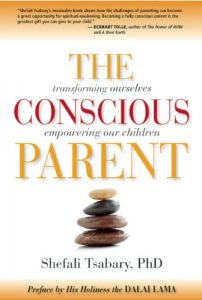
That really struck a nerve when you’re saying the two doctors that are trying to raise their child to be a doctor. That just goes against everything, right? That’s about conscious parenting. I’m actually listening to the audiobook, The Conscious Parent. It’s great, I’m loving it. I’ve got a brand new baby, a 7-month-old son. I’m going to be doing this all over again. We’ll see if he’s an entrepreneur or what he wants to do, but I’m just going to be there for him to help him to discover what that is and not force him down some path.
You prompt two thoughts. Number one, I was lucky enough growing up. My parents gave me and us so much freedom. I couldn’t imagine what my life would have been like if I were under the thumb and had the kind of structure that some of these parents put on their kids. I can’t even imagine. It would not have been pretty. I was fortunate enough to have a very entrepreneurial father and mother who just gave me so much rope to go and be free.
The other thing that reminds me of this story is writing the book is a client of mine that has built a $250 million company. Well, he was going to medical school. His parents were making him become a doctor and he was about a year or two and when he called in, he started a cleaning company, he said, “Mom, I’m not going to be a doctor. I’m dropping out and I’m going to go clean toilets.” Imagine what those parents thought when they heard that message. They became very supportive.
But listen, the other day, you got to let your birdies fly and every person needs to let their freak flag fly, in my opinion. We’re all cut out and gifted to do something and we just need to do it.
I like that. One thing that I recently did—I should have done ages ago—in the last six months took the Kolbe assessment. By now, I now know my four numbers and not surprisingly, I’m massive on QuickStart, which is 9 out of 10 for me. I’m curious where Kolbe fits in for you into your EOS framework, into the entrepreneurial leap framework, and all the tools that you’ve developed. Is this an essential adjunct? Is this something that you also highly endorse? Do you have your Kolbe scores and all that? Or is it something that’s just another way of looking at things just like Predictive Index, DISC, StrengthsFinder, the Fascinate index and all that sort of stuff?
I highly endorse Kolbe. Kolbe is one of the 20 tools in the EOS process that we teach all of our clients. I absolutely write about Kolbe in one of the chapters in this book because you mentioned QuickStart. It’s one of the greatest indicators of an entrepreneur that you have these six essential traits when you’re an 8, 9 or 10 QuickStart. In all of my experience with entrepreneurs, a high 90% of them are all 8, 9, 10 quick starts. Huge supporter believer, I’m an 8 QuickStart. I’m a big believer.
Awesome. I thought you might be. I have 3s for all my other scores in Kolbe. I guess that makes me a good simplifier but being able to gather all the data, go through all the implementation, and see everything through to the finish and stuff.
That Kolbe makes you a handful is what that does.
Every entrepreneur will not succeed in every business. One of the biggest mistakes they make is selling their successful business, start a completely different business, and then it fails. Share on XYes, I am a handful in my team.
You definitely need an integrator or you need some high follow-throughs around you. That’s the second mode in Kolbe. You need high follow-throughs and you’ll look amazing. You need that integrator, you need those high follow-throughs, and all of your ideas and projects will get executed and you’ll look like a genius. That’s the real secret.
I was doing a podcast talking about one of my secrets. I’m a great delegator. I’m so comfortable delegating, I have no issues around delegating. I describe it as I just have always had great wingmen and wing-women around me. Going all the way back to dating and all the way forward to building a business, I just have great people around me that do a lot of the heavy lifting and make me look really good. That’s what you need. That’s a wild and crazy Kolbe you got there.
Yes, it is.
Which by the way is 80% of all of my visionary entrepreneur clients. You’re in good company.
Okay. I feel better now. Any other assessments that you really like? I would rattle off a bunch like StrengthsFinder. I quite like Strengths Finder. There’s DISC, Predictive Index, Wealth Dynamics, I think.
That one I don’t know but everyone that you just rattled off. Kolbe is at the absolute top of the list. I think you just rattled off, including Culture Index are kind of all number twos for me because Myers-Briggs is another great one. I write an entire chapter called Know Thyself and it is vital that everyone listening takes these profiling tools, know thyself, know your strengths and weaknesses and build a life around that.
Kolbe’s at the top, the rest are great seconds. I have clients that use every single one that you just described and they love them. In other words, I’m not saying they use all of them. I’m saying these 10 clients use the first one you said and these 10 use the second one and they all swear by him. It’s like, it’s the rest or like on this neutral ground, all great. You tend to get drawn to your favorite one. There is no perfect one, other than Kolbe, for this kind of work but they’re all great. I know my DISC, I know my StrengthsFinder, I know my Myers-Briggs. I’m a fanatic about profiling tools and fortunately, I discovered them at 25 years old and never looked back.
That’s great. I’m right with you on that. What’s next for you? The book is out. Are you going to build a big empire as you did with EOS around these new nine tools and the essential traits and everything? Where’s the next step for you? Where’s maybe the end game?
I appreciate that. The ultimate end game is to impact a million entrepreneurs in the making, give them a huge jumpstart. I’ll never say never but I really don’t want to build another empire. I said that 20 years ago before I built the EOS Worldwide, which was an empire. We’ll see what happens. Again, I’ll never say never, but I am going to build something of a quasi empire from a standpoint of I’m taking a very unique and different approach to this model.
The plan is to build this through collaborators. I call them collaborators. My team is four people. I have a team of four people. What I say is I have four people right now and they’re all virtual. In 10 years from now, I want four virtual people. I don’t want to build an empire.
Collaborators are any organization or person that are currently helping entrepreneurs in the making. Imagine high school teachers, professors, for-profits and nonprofits, anyone that’s teaching, mentoring, guiding, and helping entrepreneurs. What I do with these collaborators is I give them my content for free. They give credit where credit’s due and it’s this match made in heaven. They get to be heroes to their audience.
Right now, I sit here with about 20 committed collaborators. I literally have 80 that I’m talking to and my goal over the next 3 years is to have 50 committed collaborators. I’m just going to keep building those collaborators and build this community of collaborators that we’re all passionate about the same thing that is using the content.
I don’t need another empire, I don’t need trillions of dollars. If I want to, I could flip this into an economic model and charge for all that, but this is a passion project. There are no contracts with those collaborators, there’s no money that exchanges hands. I am giving them the content and I believe it’s going to be a win-win. We’re all going to win and we’re going to impact a million people over the next 10 years. That’s what’s next and I can’t tell you what comes in the 10 years after that, but right now, I’m just hyper-focused on this 10-year plan.
'Everything should be thought about in 10-year timeframes. What it did for me is all of a sudden, time slowed down, I started making better decisions, and ironically, I got there faster.' - Gino Wickman Share on XWell, telepathy is the thing after that, right?
Yeah, and populating Mars. Those two things, yeah.
Two collaborators I can think of you should definitely talk to, one is Dr. Bill Dorfman. He’s the founder of the Leap Foundation. They do a lot for kids, getting them inspired to start an entrepreneurial journey that’s on Great Events. And Steve Glaveski, who’s been a guest on this show. He is the founder of Lemonade Stand. Lemonade Stand is helping young entrepreneurs kids. That would be my recommendation for you on collaborators.
Please, connect us. That would be awesome.
I would love to. Listeners, if those two folks sound interesting to you, check them out. Those two resources or organizations, Lemonade Stand and Leap Foundation. All the great resources, tools, books and everything.
If you were to maybe leave our listeners with one last piece of wisdom that we didn’t already discuss. What would that be?
I would say, I write an entire chapter on this is something that’s been the most transformative in my life in the last 18 years now. I learned this at 35 years old and it’s 10-year thinking. I write an entire chapter basically saying, take action but be patient. The whole idea is you got to move towards something.
The point here is the faster you can shift your thinking to 10-year thinking. Everything should be thinking in 10-year timeframes. What it did for me is all the sudden, time slowed down, I started making better decisions, and ironically, I got there faster. It’s this crazy kind of a counterintuitive oxymoron. I would urge, shift your thinking to 10-year thinking because prior to that, everything was now, now, now. I wanted everything to get done now this year and I would make these short-term decisions that would hurt me in the long run. Ten-year thinking is what I would leave you with.
Awesome. You said you came up with this at age 35. What is the most impactful thing that came out of applying 10-year thinking out of these last 17 years?
I would say the biggest is that we have almost 100,000 companies using the EOS tools. I think that was it. The overriding goal has always been that we, EOS, as implementers, take 10,000 companies through our process by the end of 2020. Ironically, I set that goal almost 20 years ago and we’re going to hit that goal. I never realized the exponential reach that those 10,000 would have. Literally, we’ll be well over 100,000 companies. With that long term thinking like that and the commitment to that goal, that just enabled me and us to make much better “now” decisions, knowing that every decision was all about getting there.
Yeah. Talk about long-term thinking, I think it was maybe Peter Diamandis who suggested we think in terms of 100-year goals.
Yeah, and Dan Sullivan is talking about 25 years and certainly, the Japanese think 100-year planning. Listen, I’m just trying to get people to go past 1 year to 10 years and obviously the woman here earlier, she’s getting people to think 3 years. Anything that gets people thinking further out. I’ll get into thinking 10 and then Dan can take him to 25 and then Peter can take him to 100.
Awesome. All right. The website for the book is e-leap.com. If somebody wanted to follow you and I don’t know, maybe invite you on their podcast, where can they best find you online? Are you active on any social platform? Do you have another website that you want to direct people to as well?
No. We’re on all the social platforms. But if you go to that website, e-leap.com, that’s the epicenter of everything. That’s where you’ll see all the social, use the one that works for you. That’s how you can reach out to me, that’s how you can reach out to us. It’s all there, really simple and intuitive.
Awesome. Thank you, Gino. This was just incredible. I’ve been a fan of what you’ve been doing since I heard of you and that was maybe 1½ years ago. Amazing to have Gino Wickman on the podcast. Thank you again and thank you, listeners. Please do something with this. Inspire somebody, even if you already are having great success as an entrepreneur. Find somebody that you can lift them up, give them a hand, give them the book, learn the concepts and apply it to the people who need it. We’ll catch you in the next episode. This is Stephan Spencer, your host signing off.
Links and Resources
Connect with Gino Wickman
Entrepreneurial Leap
Facebook – Entrepreneurial Leap
Twitter – Entrepreneurial Leap
Instagram – Entrepreneurial Leap
Youtube – Entrepreneurial Leap
EOS Worldwide
Facebook – EOS Worldwide
Twitter – EOS Worldwide
Youtube – EOS Worldwide
LinkedIn – EOS Worldwide
MyBiz Match

